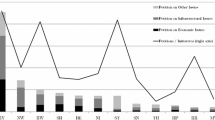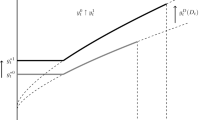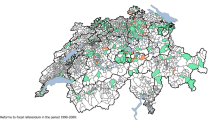Abstract
It has been shown that both formal existence and actual use of direct democratic institutions have effects on a number of variables such as fiscal policies, quality of governance but also economic growth. Further, it has been argued that direct democratic institutions would not only have an impact on policy outcomes but influence citizen participation and attitudes toward politics. For the first time, these conjectures are tested in a large cross-country sample here. Overall, we do not find strong effects and some of the significant correlations are rather small substantially. In contrast to previous studies, voter turnout is not higher when direct democracy is available or used. Further, and also in contrast to previous studies, citizens do not express a greater interest in politics in countries with direct democracy institutions. Finally, they display lower trust in government and parties but not in parliament. These results shed some doubt on the hope that direct democracy would make for better citizens.
Similar content being viewed by others
Notes
It should really be the rationally ignorant citizen—as the theory also predicts that he will not vote.
Hibbing and Theiss-Morse (2001) analyze process preferences of US American voters empirically. They find that those who support more direct involvement of citizens in decision making are simultaneously also more likely to support delegation of decision-making competence to non-elected technocrats (such as central bankers).
Note the structural similarity to the argument that a constitution for knaves—as recommended by David Hume—crowds out mutual trust between citizens and politicians (Frey 1997).
There, we find that only 20.5 % have optional referendums. This huge difference is primarily due to plebiscites that are not distinguished from referendums here. In our earlier survey, we counted 64.8 % of all countries as allowing for plebiscites, a percentage fairly close to the 68.1 % reported here.
Here is some information on the outliers in Table 3: Israel (37.1) is an outlier regarding “discuss political matters frequently”, Sweden (31.0) one regarding “joining boycotts” and Bangladesh is an outlier with regard to all “great deal” questions (all answered with their possible maximum). Data from Bangladesh might, hence, be problematic and we include a country dummy for that country.
More specifically, we test both de jure and de facto mandatory referendums as well as the de jure and de facto initiatives. To save space, we refrain from reporting the results on optional referendums as they do not convey additional insights.
In addition to the electoral system, we propose to control for the form of government, the question i.e. whether a country has a presidential or parliamentary system. This could have an influence on voter turnout regarding legislatures because under parliamentary systems, it is the legislature that determines the head of the executive. Also, presidential systems often have a form of direct citizen participation if the president is elected directly by the citizens.
A reviewer suggested that we exclude countries with compulsory voting entirely—and not control for them with a dummy as we do. Exclusion of those countries leaves the results unaffected.
With regard to MANDREF and INI, the mean for trust is even higher in the control group.
The choice of these variables as instruments is motivated in a little more detail in Blume et al. (2009).
To save space, we report results on voter turnout only on the basis of the percentage of registered voters (and drop those based on voting population).
We did run regressions with a quadratic term. The term never reached conventional significance levels though.
Results of an alternative regression that draws on voter turnout as percent of the voting population are different in the sense that none of the variables proxying for direct democratic institutions is significant.
This result remains unchanged when the dependent variable only includes the item “very interested” and not the aggregate of both “very” and “somewhat interested.” In this case, the R2 of the entire regression raises to more than 50 %.
The significant impact of MANDREF on political interest in column 5 is not robust to the inclusion of the de facto variables.
In an exemplary fashion, Table 12 shows the relationship between direct democracy and trust in parliaments. The correlation between direct democracy and the variable “how is democracy” is also insignificant.
References
Alesina, A., Devleeschauer, A., Easterly, W., Kurlat, S., & Wacziarg, R. (2002). Fractionalization, NBER working paper 9411.
Banks, Arthur S. (2004). Banks’ Cross-National Time-Series Data Archive. Binghamton, NY: Databanks International [distributor].
Beck, Th., Clarke, G., Groff, A., Keefer, Ph., Walsh, P. (2000). New Tools and New Tests in Comparative Political Economy: The Database of Political Institutions. Washington: The World Bank.
Benz, M., & Stutzer, A. (2004). Are voters better informed when they have a larger say in politics?—Evidence for the European Union and Switzerland. Public Choice, 119, 31–59.
Blume, L. (2009). Regionale Institutionen und Wachstum: Sozialkapital, Kommunalverfassungen und interkommunale Kooperation aus regional- und institutionenökonomischer Sicht. Marburg: Metropolis.
Blume, L., Müller, J., & Voigt, S. (2009). The economic effects of direct democracy—A first global assessment. Public Choice, 140, 431–461.
Butler, D., & Ranney, A. (1994). Theory. In D. Butler & A. Ranney (Eds.), Referendums around the world—The growing use of direct democracy, chapter 2. Washington, DC: AEI Press.
CIA (2005). The World Factbook. https://www.cia.gov/cia/download2005.htm.
Citrin, J. (1996). Who’s the boss? Direct democracy and popular control of government. In Stephen Craig (Ed.), Broken contract? Changing relationships between Americans and their government (pp. 268–293). Boulder: Westview Press.
Cox, G., & Munger, M. (1989). Closeness, expenditures and turnout in the 1982 US house elections. American Political Science Review, 83(1), 217–231.
Deininger, K., & Squire, L. (1996). A new data set measuring income inequality. World Bank Economic Review, 10(3), 565–591.
Donovan, T., Tolbert, C., & Smith, D. (2009). Political engagement, mobilization, and direct democracy. Public Opinion Quarterly, 73(1), 98–118.
Dyck, J. (2009). Initiated distrust. Direct democracy and trust in government. American Politics Research. doi:10.1177/1532673X08330635.
Dyck, J., & Seabrock, N. (2010). Mobilized by direct democracy: Short-term versus long-term effects and the geography of turnout in ballot measure elections. Social Science Quarterly, 91(1), 188–208.
Freedom House (2005). Freedom in the World Country Ratings 1973–2005. http://65.110.85.181/uploads/FIWrank7305.xls.
Frey, B. (1997). A constitution for knaves crowds out civic virtues. The Economic Journal, 107, 1043–1053.
Frey, B., Benz, M., & Stutzer, A. (2004). Introducing procedural utility: Not Only what, but also how matters. Journal of Institutional and Theoretical Economics, 160, 377–401.
Fukuyama, F. (1995). Trust: The social virtues and the creation of prosperity. New York: Free Press.
Gerber, E., Lupia, A., McCubbins, M., & Kiewit, R. (2001). Stealing the initiative—How state government responds to direct democracy. Upper Saddle River (NJ): Prentice Hall.
Geys, Benny. (2006). Explaining voter turnout: A review of aggregate-level research. Electoral Studies, 25, 637–663.
Golder, M. (2005). Democratic electoral Systems Around the World, 1946–2000. Electoral Studies, 24, 103–121.
Hibbing, John, & Theiss-Morse, E. (2001). Process preferences and American politics: What the people want government to be. American Political Science Review, 95, 145–153.
Hug, Simon. (2005). The political effects of referendums: An analysis of institutional innovations in Eastern and Central Europe. Communist and Post-Communist Studies, 38, 475–499.
IDEA (International Institute for Democracy and Electoral Assistance). (2008). Direct democracy: The international IDEA handbook. Stockholm: IDEA.
Knack, S., & Keefer, P. (1997). Does social capital have an economic payoff? A cross-country investigation. Quarterly Journal of Economics, 112, 1251–1288.
La Porta, R., Lopez-de-Silanes, F., Shleifer, A., Vishny, R. (1999). The Quality of Government. Journal of Law, Economics and Organization, 15(1), 222–279.
Matsusaka, J. (1995). Explaining voter turnout patterns: An information theory. Public Choice, 84, 91–117.
Matsusaka, J. (2005). The eclipse of legislatures: Direct democracy in the 21st century. Public Choice, 124, 157–177.
Matsusaka, J. (2008). Direct democracy and the executive branch. In S. Bowler & A. Glazer (Eds.), Direct democracy’s impact on american political institutions (pp. 115–136). New York: Palgrave Macmillan.
Matsusaka, J. (2010). Popular control of public policy: A quantitative approach. Quarterly Journal of Political Science, 5, 133–167.
Mueller, D. (2003). Public Choice III. Cambridge: Cambridge University Press.
Olson, M. (1965). The Logic of Collective Action. Cambridge, Mass: Harvard University Press.
Paxton, P. (2002). Social capital and democracy: An interdependent relationship. American Sociological Review, 67(2), 254–277.
Persson, T., & Tabellini, G. (2003). The Economic Effects of Constitutions. Cambridge, MA: The MIT Press.
Powell, B. (1980). Voting turnout in 30 democracies: Partisan, legal and socio-economic influences. In R. Rose (Ed.), Electoral participation: A comparative analysis (pp. 5–34). London: Sage.
Schlozman, D., & Yohai, I. (2008). How initiatives Don’t always make citizens: Ballot initiatives in the American states, 1978–2004. Political Behavior, 30, 469–489.
Smith, M. (2001). The contingent effects of ballot initiatives and candidate races on turnout. American Journal of Political Science, 45(3), 700–706.
Smith, D., & Tolbert, C. (2004). Educated by initiative. Ann Arbor: University of Michigan Press.
Tolbert, C. J., McNeal, R. S., & Smith, D. A. (2003). Enhancing civic engagement: The effect of direct democracy on political participation and knowledge. State Politics and Policy Quarterly, 3, 23–41.
Tolbert, C., & Smith, D. (2005). The educative effects of ballot initiatives on voter turnout. American Politics Research, 33(2), 283–309.
Vanhanen, T. (2000). A New Dataset for Measuring Democracy, 1810–1998. Journal of Peace Research, 37, 252–265.
World Values Study Group (2008). World Values Survey 1981-1984, 1990-1993, 1995-1997, 1999-2001, and 2005-2008. Ann Arbor: Inter-university Consortium for Political and Social Research.
Acknowledgments
The authors thank Marc Berendsen and Andreas Block for extremely valuable research assistance and the participants of the panel “Effects of Direct Democracy on Representation and Policy-Making” at the ECPR General Conference in Potsdam (2009) as well as Matthias Dauner and Sang Min Park for questions and suggestions. Two referees of this journal made very constructive and helpful suggestions.
Author information
Authors and Affiliations
Corresponding author
Rights and permissions
About this article
Cite this article
Voigt, S., Blume, L. Does direct democracy make for better citizens? A cautionary warning based on cross-country evidence. Const Polit Econ 26, 391–420 (2015). https://doi.org/10.1007/s10602-015-9194-2
Published:
Issue Date:
DOI: https://doi.org/10.1007/s10602-015-9194-2




